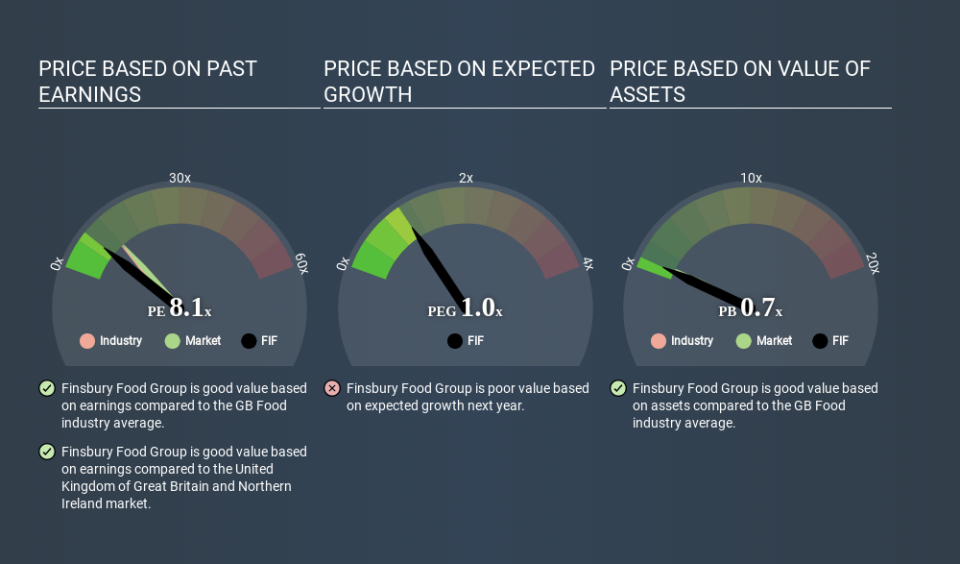What Is Finsbury Food Group's (LON:FIF) P/E Ratio After Its Share Price Tanked?

To the annoyance of some shareholders, Finsbury Food Group (LON:FIF) shares are down a considerable 38% in the last month. Even longer term holders have taken a real hit with the stock declining 2.3% in the last year.
Assuming nothing else has changed, a lower share price makes a stock more attractive to potential buyers. In the long term, share prices tend to follow earnings per share, but in the short term prices bounce around in response to short term factors (which are not always obvious). The implication here is that long term investors have an opportunity when expectations of a company are too low. One way to gauge market expectations of a stock is to look at its Price to Earnings Ratio (PE Ratio). Investors have optimistic expectations of companies with higher P/E ratios, compared to companies with lower P/E ratios.
View our latest analysis for Finsbury Food Group
How Does Finsbury Food Group's P/E Ratio Compare To Its Peers?
We can tell from its P/E ratio of 8.06 that sentiment around Finsbury Food Group isn't particularly high. If you look at the image below, you can see Finsbury Food Group has a lower P/E than the average (12.2) in the food industry classification.
Its relatively low P/E ratio indicates that Finsbury Food Group shareholders think it will struggle to do as well as other companies in its industry classification. While current expectations are low, the stock could be undervalued if the situation is better than the market assumes. It is arguably worth checking if insiders are buying shares, because that might imply they believe the stock is undervalued.
How Growth Rates Impact P/E Ratios
Generally speaking the rate of earnings growth has a profound impact on a company's P/E multiple. When earnings grow, the 'E' increases, over time. And in that case, the P/E ratio itself will drop rather quickly. And as that P/E ratio drops, the company will look cheap, unless its share price increases.
Finsbury Food Group's earnings per share grew by 6.2% in the last twelve months. And it has bolstered its earnings per share by 4.6% per year over the last five years.
A Limitation: P/E Ratios Ignore Debt and Cash In The Bank
It's important to note that the P/E ratio considers the market capitalization, not the enterprise value. That means it doesn't take debt or cash into account. The exact same company would hypothetically deserve a higher P/E ratio if it had a strong balance sheet, than if it had a weak one with lots of debt, because a cashed up company can spend on growth.
Such spending might be good or bad, overall, but the key point here is that you need to look at debt to understand the P/E ratio in context.
Finsbury Food Group's Balance Sheet
Finsbury Food Group's net debt equates to 43% of its market capitalization. While that's enough to warrant consideration, it doesn't really concern us.
The Bottom Line On Finsbury Food Group's P/E Ratio
Finsbury Food Group has a P/E of 8.1. That's below the average in the GB market, which is 12.7. The company does have a little debt, and EPS is moving in the right direction. If growth is sustainable over the long term, then the current P/E ratio may be a sign of good value. Given Finsbury Food Group's P/E ratio has declined from 13.1 to 8.1 in the last month, we know for sure that the market is more worried about the business today, than it was back then. For those who prefer invest in growth, this stock apparently offers limited promise, but the deep value investors may find the pessimism around this stock enticing.
Investors should be looking to buy stocks that the market is wrong about. As value investor Benjamin Graham famously said, 'In the short run, the market is a voting machine but in the long run, it is a weighing machine. So this free visual report on analyst forecasts could hold the key to an excellent investment decision.
But note: Finsbury Food Group may not be the best stock to buy. So take a peek at this free list of interesting companies with strong recent earnings growth (and a P/E ratio below 20).
If you spot an error that warrants correction, please contact the editor at editorial-team@simplywallst.com. This article by Simply Wall St is general in nature. It does not constitute a recommendation to buy or sell any stock, and does not take account of your objectives, or your financial situation. Simply Wall St has no position in the stocks mentioned.
We aim to bring you long-term focused research analysis driven by fundamental data. Note that our analysis may not factor in the latest price-sensitive company announcements or qualitative material. Thank you for reading.

